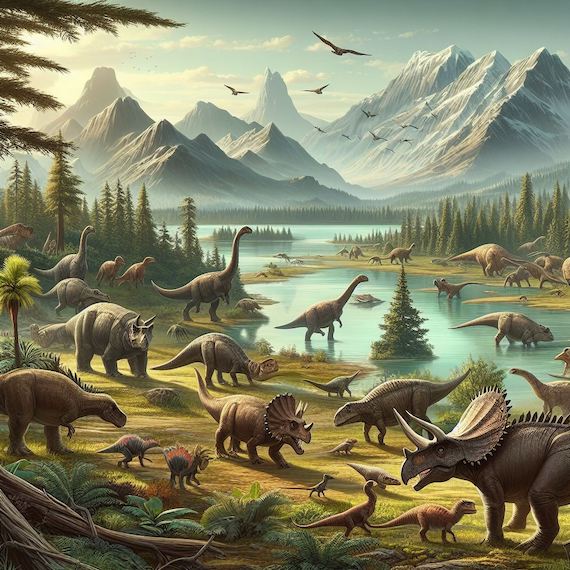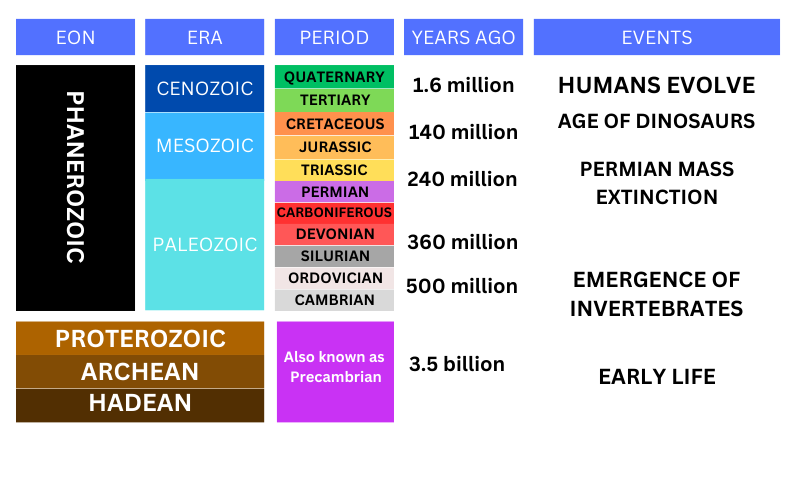Mesozoic Era
 |
| Mesozoic Era Reptiles |
Image Credit: BING AI IMAGE GENERATOR |
The Mesozoic Era, spanning a staggering 180 million years from approximately 252 to 66 million years ago, is a monumental chapter in Earth's geological history. Often dubbed the "Age of Reptiles," this era witnessed the rise and reign of iconic dinosaurs, the evolution of various reptilian lineages, and profound transformations in the planet's landscapes and ecosystems.
Triassic Period (252 to 201 million years ago):
-
Recovery and Adaptation:
- The Mesozoic Era commenced with the Triassic Period, a time of recovery following the devastating Permian-Triassic extinction event. The emergence of new life forms, including early dinosaurs, marked the beginning of the Mesozoic's narrative.
-
Rise of Archosaurs:
- Archosaurs, a group of reptiles that includes dinosaurs, crocodiles, and pterosaurs, rose to prominence during the Triassic. These diverse reptiles played a crucial role in shaping the ecosystems of the era.
-
Early Dinosaurs:
- The Triassic saw the evolution of early dinosaur species like Eoraptor and Herrerasaurus. These small, agile predators laid the groundwork for the dominance of dinosaurs in the subsequent Jurassic and Cretaceous periods.
Jurassic Period (201 to 145 million years ago):
-
Age of Dinosaurs:
- The Jurassic Period is often considered the golden age of dinosaurs, with iconic giants roaming the Earth. Diplodocus, Brachiosaurus, and Stegosaurus are just a few examples of the diverse and awe-inspiring dinosaur species that thrived during this period.
-
Pangaea and Changing Landscapes:
- The supercontinent Pangaea began to break apart during the Jurassic, leading to the formation of new oceans and the fragmentation of landmasses. This geological activity influenced climate and biodiversity across different regions.
-
Evolution of Flight:
- Pterosaurs, the first vertebrates to achieve powered flight, soared through the Jurassic skies. These winged reptiles diversified into various forms, ranging from small, agile species to large, long-necked forms like Pteranodon.
Cretaceous Period (145 to 66 million years ago):
-
Diversity and Dominance:
- The Cretaceous Period continued the reign of dinosaurs, showcasing an even greater diversity of species. Predatory theropods like Tyrannosaurus rex and herbivorous ceratopsians like Triceratops became apex predators and herbivores.
-
Flowering Plants and Coevolution:
- The Cretaceous witnessed the evolution and proliferation of flowering plants, which had a profound impact on terrestrial ecosystems. The coevolution of plants and herbivorous dinosaurs influenced the evolution of both groups.
-
End of an Era:
- The Mesozoic Era concluded with a cataclysmic event—the Cretaceous-Paleogene (K-Pg) extinction event. A large asteroid impact, volcanic activity, or a combination of factors led to the mass extinction of dinosaurs, along with numerous other plant and animal species.
Legacy and Significance:
-
Paleontological Riches:
- The Mesozoic Era has left an indelible mark on the field of paleontology, providing a wealth of fossils that offer insights into the evolution and diversity of ancient life forms. The study of Mesozoic fossils continues to shape our understanding of Earth's history.
-
Evolutionary Transitions:
- The Mesozoic Era witnessed pivotal transitions in the evolution of life, from the emergence of mammals and the dominance of dinosaurs to the evolution of flight in pterosaurs and the development of flowering plants. These evolutionary milestones set the stage for the subsequent Cenozoic Era.
